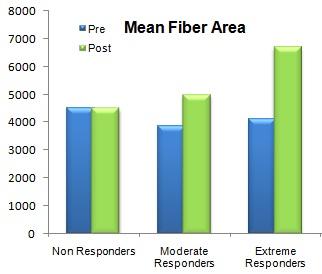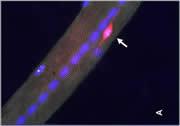Anoop, great article as usual.
Just fix the “reference” link
😊
Why Some Grow Muscle Easily While Some Don’t?
June 01 2010
The study shows why some folks grow like a weed while other struggle.
The study recruited 66 subjects.The training included 3 sets of squats, Leg Press and Leg Extensions 3 days/week for 16 weeks.
What were the results?
Based on the muscle fiber size, the participants were divided into three groups independent of age or sex ( using new method called cluster analysis):

Extreme Responders: 58% increase in muscle fiber size
Moderate Responders: 26% increase in muscle fiber size
Non Responders: 0% increase in muscle fiber size.
What are satellite cells and muscle nuclei?
Before you can understand the results of the study, you need to be familiar with some terms. I will keep it simple and short, promise.
Unlike other cells in the body, muscle cells (or muscle fibers) are multinucleated. Considering how a muscle cell is way larger and complex than the rest of the cells in the body, it makes a lot of sense to have more than one nuclei to control the complex tasks in the muscle.
For instance, if your favorite restaurant was a muscle and the cooks the nuclei, it’s pretty safe to say that the number of cooks sets the limit to the size of the restaurant. Similarly (or somewhat), the size of your muscle is ultimately limited by the number of nuclei you have in your muscle.
Simply put, you cannot grow bigger muscles without additional nuclei to take care of the extra muscle.
So where do we get these nuclei from?

Figure: A muscle fiber with nuclei shown in blue and satellite cell shown in red.
These muscle nuclei sprouts from specialized cells around the muscle called satellite cells. So any increase in satellite cells means some of these cells could be “blossoming” into new nuclei.
So how did the extreme responders grow muscle easily?
- The extreme responders had higher satellite cells to begin with. The authors speculate that your muscle growth potential is partly dependent on the availability of satellite cells before training.
- The satellite cell pool increased a remarkable 117% in the extreme responders during training.
- After training, the Extreme responders had significantly more myonuclei per fiber than Non and Moderate groups .
NOTE: It is interesting to note that 1/4(non-responders) of the subjects experienced no growth. The authors speculate that this might be because of a lack of greater recovery period between workouts and/ or additional weeks of training. Studies with 2 days/week has shown better results in older adults.
Practical Recommendations
- The extreme responders in the study are the genetic freaks who can do whatever and still grow like a weed. So don’t think it is their program as most folks do, and copy it blindly.
- As far as I know, the only natural way to increase satellite cells is by creatine. Creatine has shown to increase satellite cells substantially compared to training without creatine.
Related Articles
Anoop, can it’s be an explanation of lagging body parts as well? I mean outside of unbalanced training of cause
So,
A person with superior genetics can become stronger quickly and grow muscle; a person with less superior genetics will grow muscle at a slower rate; they are called ‘moderate responders’........
Are non-responders also called ‘hard gainers?’
I take a weight gain supplement and it says on the label: “is the ideal formula for hard gainers.”
Anoop | Wed June 02, 2010
@Anatoly
Thanks! I fixed the link.
I would say definitely yes. One of the studies have shown that soleus muscle protein synthesis is 200 times lower than the quad muscles. All the protein synthesis start from the nucleus. So I would say that’s part of the reason.
@ Steve
Hardgainers are people who find it hard to put on body weight, not necessarily muscle.
It’s surprising the non responders didn’t put any muscle.
More of the same:
http://www.ncbi.nlm.nih.gov/pubmed/17395765
the full text of this is free if you click the link.
MGF and myogenin are also differentially expressed between high, medium and non responders.
Another interesting find in that study was this:
By midtraining, all three clusters realized substantial increases in strength (Non 30.5%, Mod 25.6%, Xtr 29.4%) (P < 0.001). The interaction was driven by the failure of Non to increase knee extension strength beyond the midtraining time point. From midtraining (week 8) to posttraining (week 16), only responders continued to make strength gains (Mod 10.2%, P < 0.005; Xtr 12.5%, P < 0.001).
When you look at strength, non responders (those who had NO hypertrophy) actually increase the most in strength. This was at the midtraining time point.
Hypertrophy wasn’t measured here, so we don’t know how it relates to that at midtime. If noticeable hypertrophy had occured here, you would have to assume the neural adaptations in the non group was actually higher than in the other groups.
Or, if noticeable hypertrophy hadn’t happened here yet (fitting with the usually taught concept of neural adaptations first, then hypertrophy) it just means that neural adaptations are pretty similar between responder clusters.
Another interesting find was that pre training distribution of fiber types did not differ significantly between the clusters. You’d think people with more type II fibers would be more likely to be in the extreme group.
“noticeable hypertrophy hadn’t happened here yet (fitting with the usually taught concept of neural adaptations first, then hypertrophy) it just means that neural adaptations are pretty similar between responder clusters. “
this sounds about right.
“The extreme responders in the study are the genetic freaks who can do whatever and still grow like a weed. So don’t think it is their program as most folks do, and copy it blindly. “
^ this is how muscle mags make their $$$
Nick Outlaw | Thu June 10, 2010
I would like to see the data of each participants background, exercise history. I guarantee the ones w/ no response had being doing a simalar routine like the one tested for a long duration and the ones that were extreme responders had never done a routine like that one before or only rarely. Refer to muscle memory and the adaptation response. Just my initial thoughts from reading the article, thanks for the info!
Nick Outlaw
“Subjects had not experienced any leg resistance training in the previous 5 yr before initiating the study protocol.”
from the study. Of course, we don’t know anything before that, but it seems to me these were untrained people.
Hello,
Iam 29 years of age,weigh 74kgs and iam 8 mths old in the gym..
I take creatine(5gram) + dextrose(5 teaspoon) + vitamin c 1000mg + antoxyforte cap immediately after the workout..
In 8 mths what i gain
Biceps
12 to 13
Thighs
16 to 24
chest
39 to 40
shoulders
17 to 18
Sir i love biceps,in just 2 mths mince bicep size increase from 12 to 13inch and thereafter it stop to grow,its still 13inch and its not growing,i lift really heavy weight…below are mine workouts
DAY1
FLAT BENCHPRESS
INCLINE BENCHPRESS
DECLINE DUMBELL PRESS
CHEST PRESS
DAY2
SQUAT
OVERHEAD PRESS
DUMBELL SHRUG
DAY3
BARBELL CURL
PREACHER CURL
MACHINE PULL DOWN FOR TRICEPS
PLS HELP ME IN GROWING MINE BICEPS,I WILL NEVER EVER FORGET U IF U HELP ME IN GROWING MINE BICEPS….
Time to change things up a bit maybe. Try to hit every muscle at least twice a week with an FBW (3 times a week) a push-pull split or an upper-lower split. Sign up to the forums and make a thread, that way we can probably help you more.
Andy Walsh | Wed June 23, 2010
Question:
Inside a mucle fibre are myofibril, then inside those are the contractile filaments: actin and myosin.
So where are these ‘nuclei’ located?
And has anyone in this study made reference to somatotypes?
The nuclei are usually located towards the outline of the cell. Here’s a pic to help you see:
http://www.google.no/imgres?imgurl=http://cal.vet.upenn.edu/projects/histo/Lab9muscle/lab9images/s37_skeletal40x.jpg&imgrefurl=http://cal.vet.upenn.edu/projects/histo/Lab9muscle/Lab9as37musc40x.htm&usg=__EIJmDsW1jpmWGCR75B4hwD7O1DU=&h=294&w=400&sz=37&hl=no&start=1&um=1&itbs=1&tbnid=Wr61qezA0DvS7M:&tbnh=91&tbnw=124&prev;=/images?q=skeletal+muscle+nucleus+location&um=1&hl=no&client=opera&sa=N&rls=en-GB&tbs=isch:1
Trying that link again:
http://cal.vet.upenn.edu/projects/histo/Lab9muscle/lab9images/s37_skeletal40x.jpg
the number 3 arrows point towards nuclei. The pic to the left is a cross section, the one to the right is a longditudional section.
Alabama | Wed October 27, 2010
If Marcas Bamman [or any of his colleagues] saw how terribly you butchered his data in hopes of gaining some ‘practical’ knowledge for your own selfish pursuits in muscle gain….
1) This data is in support of aging populations and NOT for speculative comparisons of general populations.
2) Creatine is not a worthy satellite cell stimulant. Google: leucine supplementation, IGF or Glucose Supplimentation on Effects of satellite cell proliferation
3) Leave the interpretation of the data to the true reviewers of these journals
- NOTE: JAP Membership can not be given out to Masters Students
Anoop | Wed October 27, 2010
Hi Alabama,
Thanks for the critique.
1. I have copied the text you missed fromthe study.
Subjects:Sixty-six adults were recruited from the Birmingham, Alabama metropolitan area into two age groups. Inclusion into the study was based on age ranges of 60–75 yr for the older adults and 20–35 yr for the younger group .
Also the conclusion from Bamman: These findings strongly suggest myonuclear addition via SC recruitment may be required to achieve substantial myofiber hypertrophy in humans.
2. Check this article: http://www.exercisebiology.com/index.php/site/articles/how_creatine_works/
3. Reviewers do not interpret data. They check the validity of the study. Data is data. I was only a year away from my Ph.D. So my second Master’s was infact my Ph.D.
Boston DUI lawyer | Thu December 16, 2010
I think that the three levels are influenced by both genetics and external factors. People who are not extreme responders can probably be pushed into that category with extreme stress. Has there been any studies on that?
how about myostatin levels? i’ve heard we can only grow as myostatin allow us to. low level of myostatin results in greater muscle mass. like belgian blue bulls.
To anyone who doubts the influence of genetics: I’ve trained for 10 years using every imaginable protocol, with very few gains.
Of course, I dont need to do steroids or eat 10 egg whites to understand that my body simply is not meant to respond to weight-training.
In all probability, given a minimum level of training and nutrition, the only significant variables affecting results are hormonal response and genetic make-up, and not the training protocol or nutrition strategies.

